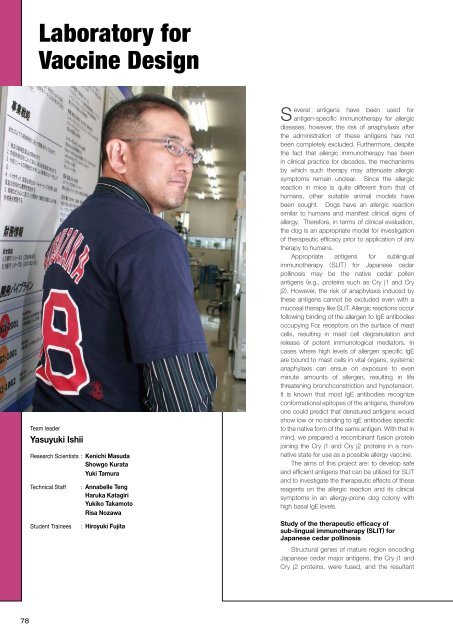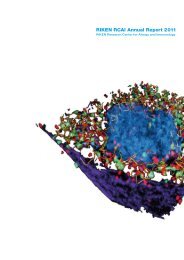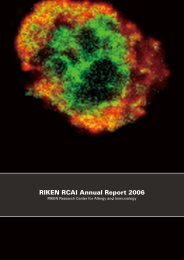in vivo
in vivo
in vivo
Create successful ePaper yourself
Turn your PDF publications into a flip-book with our unique Google optimized e-Paper software.
Laboratory for<br />
Vacc<strong>in</strong>e Design<br />
Team leader<br />
Yasuyuki Ishii<br />
Research Scientists : Kenichi Masuda<br />
Showgo Kurata<br />
Yuki Tamura<br />
Technical Staff<br />
Student Tra<strong>in</strong>ees<br />
: Annabelle Teng<br />
Haruka Katagiri<br />
Yukiko Takamoto<br />
Risa Nozawa<br />
: Hiroyuki Fujita<br />
Several antigens have been used for<br />
antigen-specific immunotherapy for allergic<br />
diseases, however, the risk of anaphylaxis after<br />
the adm<strong>in</strong>istration of these antigens has not<br />
been completely excluded. Furthermore, despite<br />
the fact that allergic immunotherapy has been<br />
<strong>in</strong> cl<strong>in</strong>ical practice for decades, the mechanisms<br />
by which such therapy may attenuate allergic<br />
symptoms rema<strong>in</strong> unclear. S<strong>in</strong>ce the allergic<br />
reaction <strong>in</strong> mice is quite different from that of<br />
humans, other suitable animal models have<br />
been sought. Dogs have an allergic reaction<br />
similar to humans and manifest cl<strong>in</strong>ical signs of<br />
allergy. Therefore, <strong>in</strong> terms of cl<strong>in</strong>ical evaluation,<br />
the dog is an appropriate model for <strong>in</strong>vestigation<br />
of therapeutic efficacy prior to application of any<br />
therapy to humans.<br />
Appropriate antigens for subl<strong>in</strong>gual<br />
immunotherapy (SLIT) for Japanese cedar<br />
poll<strong>in</strong>osis may be the native cedar pollen<br />
antigens (e.g., prote<strong>in</strong>s such as Cry j1 and Cry<br />
j2). However, the risk of anaphylaxis <strong>in</strong>duced by<br />
these antigens cannot be excluded even with a<br />
mucosal therapy like SLIT. Allergic reactions occur<br />
follow<strong>in</strong>g b<strong>in</strong>d<strong>in</strong>g of the allergen to IgE antibodies<br />
occupy<strong>in</strong>g Fcε receptors on the surface of mast<br />
cells, result<strong>in</strong>g <strong>in</strong> mast cell degranulation and<br />
release of potent immunological mediators. In<br />
cases where high levels of allergen specific IgE<br />
are bound to mast cells <strong>in</strong> vital organs, systemic<br />
anaphylaxis can ensue on exposure to even<br />
m<strong>in</strong>ute amounts of allergen, result<strong>in</strong>g <strong>in</strong> life<br />
threaten<strong>in</strong>g bronchconstriction and hypotension.<br />
It is known that most IgE antibodies recognize<br />
conformational epitopes of the antigens, therefore<br />
one could predict that denatured antigens would<br />
show low or no b<strong>in</strong>d<strong>in</strong>g to IgE antibodies specific<br />
to the native form of the same antigen. With that <strong>in</strong><br />
m<strong>in</strong>d, we prepared a recomb<strong>in</strong>ant fusion prote<strong>in</strong><br />
jo<strong>in</strong><strong>in</strong>g the Cry j1 and Cry j2 prote<strong>in</strong>s <strong>in</strong> a nonnative<br />
state for use as a possible allergy vacc<strong>in</strong>e.<br />
The aims of this project are: to develop safe<br />
and efficient antigens that can be utilized for SLIT<br />
and to <strong>in</strong>vestigate the therapeutic effects of these<br />
reagents on the allergic reaction and its cl<strong>in</strong>ical<br />
symptoms <strong>in</strong> an allergy-prone dog colony with<br />
high basal IgE levels.<br />
Study of the therapeutic efficacy of<br />
sub-l<strong>in</strong>gual immunotherapy (SLIT) for<br />
Japanese cedar poll<strong>in</strong>osis<br />
Structural genes of mature region encod<strong>in</strong>g<br />
Japanese cedar major antigens, the Cry j1 and<br />
Cry j2 prote<strong>in</strong>s, were fused, and the resultant<br />
78





